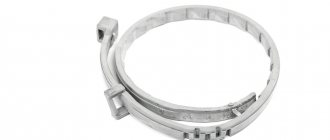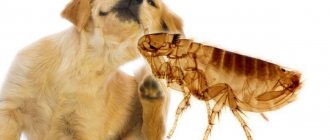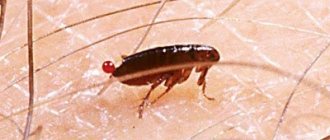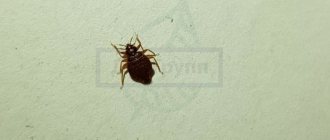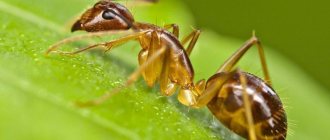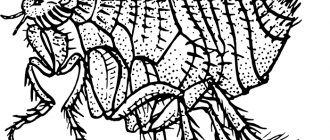Ctenocephalidosis (fleas in cats) is the most common disease among domestic and stray cats. Insects not only cause discomfort to animals, but are also carriers of infectious diseases and intestinal parasites. To prevent the development of serious illnesses, you need to regularly treat your pet. Let's find out what signs indicate the presence of fleas in a cat.
Difficulties in diagnosing flea infestations
Cats are very clean animals; they are capable of licking their fur for 4-5 hours a day. Due to such active hygiene, pets are able to independently catch biting parasites in their fur, lick and swallow their excrement. In addition, fleas do not live permanently on the animal’s body, but only feed on blood. The rest of the time, fleas “travel” around the apartment. Favorite places for their localization and reproduction are carpets, baseboards, and cracks in the floor.
It is these two facts that make it difficult to visually diagnose the presence of parasites on an animal’s body. You can independently determine that a cat has fleas if the animal is not aggressive and is handled.
The methods described below will help with this. But to find fleas in an aggressive cat, it is better to go to a veterinary clinic, where a specialist will securely restrain the animal, examine and treat it.
How to get rid of fleas in an apartment: quickly and safely
What measures should you take if your pet has fleas? How to get rid of fleas in an apartment or house? While there are a huge number of effective medications for fluffies, the situation with treating apartments and other premises is much more complicated.
Fleas often live in the basement of a house and entrances, so they easily penetrate apartments, especially if it is located on the first floors. The source of infection can be the owner himself, bringing insects on his clothes or shoes.
To get rid of fleas in an apartment, it is necessary to carry out complex treatment, that is, simultaneously poison the insects from the pet and disinfect the room in which it lives.
We have already found out what medications there are for treating cats: shampoos, collars, tablets, drops, sprays. There are a lot of products and almost all of them are effective, the main thing is to trust those manufacturers who have a good reputation. It is much more difficult to kill fleas in their habitat. Especially if it is a living space. Why? Read on..
Life cycle of flea development
The life cycle of a flea in a cat consists of four stages:
- Egg.
- Larva.
- Doll.
- An adult ready to reproduce.
Please note that only 5% of the total population of insects bite. Therefore, it is better not to even try to imagine how many of these nasty insects there are in your apartment. And immediately proceed to the destruction of vectors of infection.
How eggs are laid:
A sexually mature creature literally shoots its eggs into the external environment and over quite long distances. Therefore, it is not surprising if you have washed the cat and cleaned its fur, and after some time you again notice larvae stuck to the surface of the fur coat. This happened because the purr rubbed its skin against an untreated surface.
Eggs can be found anywhere: behind cabinets, on baseboards, floors and even beds, absolutely everywhere.
Developing larvae look like small worms, only a few millimeters in size. They are active and very voracious. They feed on the waste products of their relatives and other organic waste found in house dust and dirt. Next, the larva turns into a pupa, and this, by the way, is the last stage, after which an adult hatches.
While eggs and larvae are destroyed relatively easily, the pupal stage is very resistant to almost all influences. Therefore, the treatment should be repeated after 10 - 14 days. Otherwise there will be no sense.
How to get rid of fleas in an apartment (house), treatment with folk remedies
The safest method is to use a steam generator . Direct the hot jet to areas where fleas are found.
Baby soap and onion (garlic) . Use as a preventive measure. Grate the piece, dissolve it in warm water and add the onion. Wash the room and give your furry pet a bath.
It is better to take things that can be removed out into the sun and fry well for several hours.
Chamomile . How to prepare a herbal flea repellent liquid. Take dried inflorescences, measure out two glasses, fill with water. When the infusion has cooled, rinse all the cracks in the floor, baseboards and places where your pet most often spends time. You can also wash the animal’s fur with the prepared broth, and then rinse with running water.
Salt and soda . These two ingredients need to be diluted in water at the rate of one tablespoon per 1 liter and wet cleaning done. If possible, leave the room for a while with the cat, combine salt with soda and sprinkle on surfaces for 10 hours. Remove the powder using a vacuum cleaner or simply rinse with water.
Essential oils of anise, cloves, mint, geranium and eucalyptus successfully repel insects. Use aromatherapy, it will not only get rid of fleas, but will also have a beneficial effect on your well-being.
Tar soap is also often used in the fight against blood-sucking insects. The treated surfaces will acquire a specific smell that will even rid the apartment of larvae. The cat should be washed with tar soap and then rinsed with warm water.
How to get rid of fleas in an apartment (house) using chemicals
The main difficulty in completely exterminating cat fleas in an apartment is due to the fact that all surfaces in it are literally stuffed with eggs, larvae, and pupae. They are concentrated everywhere, even in hard-to-reach places. But how to get rid of them and not cause harm to those who live in the house. How can a person protect himself from the negative effects of drugs?
We destroy cat fleas in three stages:
- First of all, you need to choose the most effective and safe flea drug. It is advisable not to risk your health and buy a less toxic product.
- In the second, we carry out a thorough general cleaning, including walls 1.5 meters high from the floor. If you use a vacuum cleaner, do not forget to throw out the bag from it. Otherwise, the flea larvae and eggs that got there begin a new cycle.
- After all surfaces have been washed, treat them with an insecticidal preparation (from the group of pesticides). After two weeks, repeat the second and third steps.
An effective substance against blood-sucking pests is Pyrethrin . Derived from chamomile flowers, which means it is non-toxic to people and pets. After spraying, fleas die within a few days from suffocation.
Special insect control services use Permethrin . It is less safe, but also effective. It is usually used for non-residential premises. You can use it at home, but it is better to give preference to the first option.
Fipronil is a synthetic insecticide found in many medications. When renovating an apartment, it is recommended to also treat animal hair. This will avoid re-infection.
Additional agents: piperonyl butoxide, chlorpyrifos. (strengthen the effect of the main component)
To combat cat fleas, many people also use veterinary products, for example, neostomazan , which is sold in 1 ml ampoules. The solution is prepared in a ratio of 1 ml per 500 ml of water and then, using a regular household spray bottle, is sprayed in places where insects are most likely to accumulate.
After treating with insecticides, the room should be closed for a couple of hours, and then thoroughly checked and wet cleaning of all treated areas.
Carpets are a little more difficult; they need to be treated and left for a while. It is advisable to take them out of the room to avoid toxic effects on humans and cats. It is better to use boric acid for antiseptic purposes. Be sure to wear chemical protective equipment. After two weeks, disinfection with chemicals will need to be repeated. And after another 2, carry out general cleaning.
Detection of parasites on an animal
The easiest way to understand that a cat has fleas is to carefully examine its fur for the presence of small insects running and jumping. To do this, the cat needs to be seated on the owner's lap, parted the fur and examined in the area of the chin, neck, spine, abdomen, groin and tail.
The most fleas will be in those places where cats cannot lick themselves.
If the cat is nursing, then you need to inspect each kitten - in babies, fleas are often localized on the head and stomach.
What fleas look like: they are small (2-3 mm) black wingless insects whose body has an oval shape and three pairs of prehensile legs. They are distinguished by incredible jumping ability and speed of movement among the hairs, so it is almost impossible to catch them with your fingers.
Important! Fleas can live without food for several months. That is why, if active insects are detected on a cat, you should definitely treat the entire apartment with effective flea remedies.
How do they reproduce?
On cats, these insects reproduce very quickly, and only a few days are enough for the animal to be completely “occupied” by reptiles .
Like all blood-sucking creatures of this type, fleas lay small eggs on the animal’s hair.
It is worth mentioning that eggs can only be laid by a well-fed female who has been parasitizing the pet for some time. The clutch can be of different sizes: it all depends on the conditions, the condition of the parasite and the environment.
Detecting eggs is quite difficult : this will require special equipment, because the size of future parasites is very small.
After 1-4 days, pupae hatch from the eggs, which develop into worms that feed on the skin of the animal, excrement of mature individuals, litter, etc. After 1 - 3 weeks, the pupa turns into a full-fledged individual, which can be seen on the cat.
Study the article about flea drops for cats, as well as reviews of some brands: Stronghold, Advocate, Advantage, Inspector, Bars, Frontline.
Detection of insect feces
Reliable signs of the presence of fleas (in addition to the detection of live insects) is the presence of their feces. They look like brown-red or black dots located on the skin at the base of the hairs. When crushed between the fingers, the feces crumble and leave a reddish mark.
With a small number of insects, black spots are most often localized in a cat in the abdomen, spine and at the base of the tail.
Wet paper test
If the cat has a dark color or very thick fur, then visual diagnosis of the presence of ectoparasites will be difficult. There is a simple and proven method with wet paper. With its help, you can check the fur quickly and without stress for the animal.
To do this, you will need to spread sheets of white paper on the floor (you can use pieces of old wallpaper) and place a cat in the center. Next, caress the pet, pet it, comb it, fluff the fur a little to shake out any debris and dust particles. Particular attention should be paid to cleaning the fur in the area of the belly, tail and muzzle.
Then you need to carefully examine the surface of the paper. If black dots are found, they are sprayed with water from a spray bottle.
If the result is positive, black dots on damp paper will be blurred by a dark burgundy (brown) halo. This is flea feces. Since insects feed on blood, it is present in their excrement and, under the influence of water, colors the white sheet. The more dark stains there are, the more fleas there are.
Why are cat fleas dangerous?
Infection with them is dangerous not only because of the deterioration of your pet’s general condition; there are also other reasons why you should rid your animal of these parasites as quickly as possible. These are diseases that are transmitted by fleas and can be dangerous for both the cat and its owners.
Danger for cats
In addition to a noticeable deterioration in physical and mental condition, fleas very often cause allergic dermatitis. Also, these insects are carriers of helminths. To date, it has been proven that these parasites are intermediate hosts of several dozen species of worms. The larvae feed on worm eggs, and they are also stored inside the adult insect. A cat may well become infected with helminths by biting into insects.
Fleas are carriers of infectious anemia - hemobartonellosis, which leads to a decrease in red blood cells in the animal's blood. They also carry dangerous fungal and viral diseases. Among them are mycoplasmosis - it affects various organs, as well as rickettsiosis - a disease characterized by a febrile state of the animal.
Severe infestation with them can lead to complete or partial baldness of the pet - the lost hair will never grow back. In addition, your pet may develop serious mental problems.
Danger for kittens, pregnant and lactating cats
Fleas pose an even greater danger to kittens. A fragile body is not able to fight parasites, so they often cause their death. Flea infestation in kittens leads to the following consequences:
- rapid weight loss and cessation of growth;
- the occurrence of anemia.
It is this disease that most often causes the death of an animal.
Parasites are also dangerous for pregnant cats. They deprive them of nutrients and weaken the animal. There is one more point - many of the anti-flea drugs are toxic. Their entry into the body of a pregnant woman can negatively affect the offspring. The situation is similar with feeding animals. Veterinarians advise to carry out the destruction of parasites before future mating, so you can avoid the harmful effects of parasites and medications.
Danger to humans
Cat fleas also bite humans, although they do so reluctantly and quite rarely. As mentioned above, these insects have a rather narrow specialization and prefer to feed on the blood of one host. Bites are fraught with both minor troubles and serious consequences, in the form of dangerous diseases carried by parasites.
When bitten, the parasite injects an anesthetic and an anticoagulant into the victim's body, which prevents blood clotting. Both of these proteins are foreign to us, and the human immune system instantly reacts to this - an allergic reaction begins (itching, burning, inflammation). Multiple bites disfigure the skin, it becomes covered with wounds and scratches. The legs suffer the most; the insect can jump up to about a person’s knee.
There is another danger - diseases that fleas carry:
- pulicosis;
- massive dermatitis;
- dipylidosis;
- brucellosis;
- creeping erythema;
- anthrax.
Presence of cucumber tapeworm segments in feces
Another way to tell if your cat has fleas is to look in the litter box immediately after your pet defecates and examine the fresh feces. In them you can find white moving inclusions of oval shape, similar to Fig. These are segments of the cucumber tapeworm, an intestinal parasite that enters the body of cats through fleas.
A little history of cucumber tapeworm infection
Dipylidiasis is a disease that develops when a cat accidentally swallows an infected flea that contains parasite eggs in its stomach. A flea that enters the gastrointestinal tract is digested, and the tapeworm egg goes through several stages of development in the intestine.
As a result of metamorphosis, the worm grows up to 70 cm in length. Parasitologists call it the cucumber tapeworm.
For 1 year, the helminth lives in the cat’s intestines and constantly excretes parts of its body (segments) filled with a new batch of eggs with feces. It is also possible for the worm's segments to randomly fall out of the cat's anus when the pet is sleeping or sitting in the owner's arms. Subsequently, the eggs end up on animal bedding and are eaten by flea larvae, and the development cycle repeats.
Important! A person can become infected with dipilidia only if they swallow a flea.
Expert opinion
Chepa Natalya Semenovna
Veterinarian
Ask a Question
Among cats, fold-eared breeds are most prone to otitis, because... they have a small closed ear and a narrow ear canal that is poorly ventilated. Hairless breeds produce a lot of sulfur, which can also be a predisposing factor for the development of otitis media. A common mistake owners make when caring for their ears is using a cotton swab. It will not be possible to clean the ear well with a cotton swab due to its structure, but leaving the cotton swab, “compacting” the wax inside the passage and causing irritation of the skin of the ear canal is quite likely. For home care, it is best to use special lotions no more than once a month. You should not use multi-component ear drops on your own. Medications should be prescribed by a doctor based on a cytological examination.
Prevention measures
To prevent re-infection of the animal, you must adhere to the following recommendations:
- to avoid the appearance of worms, give the cat anthelmintic medications in parallel with flea medications;
- limit your pet’s contact with street cats and stray animals;
- Regularly treat the cat’s most frequent areas and toys with disinfectants, and thoroughly vacuum the carpets;
- After treating the cat with the products, make sure that he does not lick the drug;
- It is not recommended to bathe the animal for 2-3 days after applying the drug.
If you follow these simple rules, you can easily remove blood-sucking insects and your pet will delight you with its excellent mood and good health.
Characteristic symptoms
As the disease progresses and insects spread throughout the house, the following characteristic signs appear:
- The cat has constant itching in different places, which is why it can twitch, jump up sharply, shake its head and vigorously scratch the flea bites.
- Remains of “garbage from blackheads and fur” after the cat sleeps or on the owner’s clothes. Observed when there is a high degree of flea infestation in a pet.
- Deterioration in the quality of the animal's fur (dullness, fragility, bald spots).
- Jumping fleas on carpets and furniture in the house (parasites are especially noticeable on light-colored things).
- The appearance of bites in children and other family members (on the legs and arms).
- Infection of other pets.
The appearance and intensity of development of the listed symptoms will depend on the size of the flea population in the room. If you do not provide help to the cat and without carrying out pest control measures, the symptoms will only increase.
Itching, scratching
This is the first characteristic symptom by which you can quickly find out whether your cat has fleas or other ectoparasites. In healthy animals, the ritual of hygiene of the coat and body includes licking, occasional scratching, and biting their claws to cleanse them of dirt. And a flea-ridden pet carries out all these procedures with intense scratching and biting.
As a result, the fur begins to fall out in clumps. Bald spots appear on the body (especially at the base of the tail), and bald spots on the face (under the ears) increase.
Due to constant itching and scratching on the body, the cat develops non-healing wounds from claws, which the animal additionally licks and scratches. All this further complicates the healing process.
Anemia of kittens
Anemia is a disease of the circulatory system that is described as a decrease in blood volume in the body or a decrease in the number of red blood cells and hemoglobin. Anemia develops as a consequence of some pathological condition in the animal’s body (in this case, flea infestation).
There is a theory that one flea per day is capable of drinking 1 drop of blood, and if the number of individuals is in the dozens, and everyone feeds on a weakened young body, then the likelihood of developing anemia in kittens becomes very high. If treatment is not carried out, the animal will become weak and may die.
Symptoms of anemia development:
- pale mucous membranes (the almost white color of the mucous membrane in the kitten’s mouth is indicative);
- weakness and low mobility;
- loss of appetite or complete refusal to feed;
- dyspnea.
Unfortunately, among newborn kittens with massive flea infestation, the percentage of deaths from acquired anemia is high.
Flea allergic dermatitis
Some cats are highly sensitive to flea bites and their saliva. This reaction is expressed by focal or extensive alopecia (baldness), scaly skin and inflammatory processes.
The clinical picture may be aggravated by the appearance of swelling, redness and severe itching at the bite sites. The cat becomes nervous, sleeps and eats poorly, expresses anxiety with frequent meows and constantly itches.
The wounds bleed, which further attracts fleas. Veterinarians call this pathology allergic flea dermatitis.
How does a domestic cat get fleas if he doesn't go outside?
If the cat is an indoor cat and doesn’t walk outside at all, where did he get fleas from? Flea eggs and larvae can get into an apartment from the street from a person - we can, without knowing it, bring them on shoes or clothes. If there are mice or rats in the house, they can carry fleas and cause an infestation for your cat. Also, the presence of other pets in the house, such as dogs, can affect the spread of fleas to other human friends. Fleas can move into your house from neighbors or from the entrance when you simply open the door to the landing. If a domestic cat likes to walk on the balcony, fleas can overtake it there too, coming from neighbors or from a pigeon perched on the balcony, and then the owners can guess where the cat got fleas from. So a cat doesn’t have to walk outside to pick up parasites - fleas and other insects. Find out the answer to the question, can cat fleas bite humans? The answer is in the article at the link.
